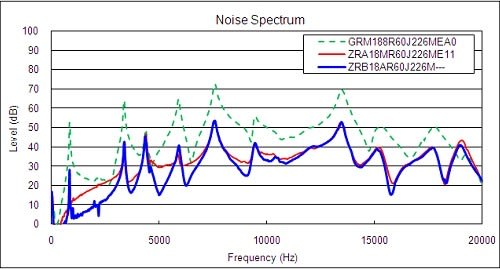Solving Squealing with Murata
Follow articleHow do you feel about this article? Help us to provide better content for you.
Thank you! Your feedback has been received.
There was a problem submitting your feedback, please try again later.
What do you think of this article?
There is a problem caused by advances in electronic design. The latest electronic devices tend to generate less noise and, as a result, “squealing” caused by capacitor vibration (not easily audible before) has emerged as a problem. It affects the design of such everyday equipment as power supply circuits for laptop PCs, smartphones, and digital still cameras.
To counter this, Murata introduced its MLCC with an interposer substrate (ZRA series) to the market as one of the products with countermeasures for squealing. The ZRA series uses an interposer substrate to suppress the vibration of capacitors and thus minimizes its effect imposed upon main circuit boards. Since the ZRA series uses an interposer substrate whose overall size is larger than that of an MLCC, there has been a problem regarding its location on a circuit board, particularly when there are short distances between components on boards to save space and provide a smaller footprint.
To solve this problem, Murata has newly developed an MLCC with an interposer substrate (ZRB series) of the same size as that of an MLCC by improving technology for mounting MLCC on a small substrate. This development makes it possible to replace previous MLCCs with the new MLCC with an interposer substrate (ZRB series) that provides countermeasures for squealing without having to modify the printed circuit board design.
Features
The MLCC is mounted on an interposer substrate that enables it to reduce the squealing level. The size of this product is the same as that of previous MLCC. Therefore, currently used MLCC can be replaced with this new product without having to modify the printed circuit board design.
The following chart shows a typical example - it is a comparison between the measured squealing levels of the new product (the ZRB series), the previous generation (the ZRA series), and a more traditional MLCC (in this case, Murata's GRM series).
The ZRB series is available from RS Components - click here to start buying now.


